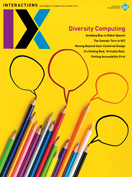Authors:
Gilbert Cockton, Simone Barbosa
Now into the second half of our term as editors in chief, we have seen some clear trends in Interactions. This issue continues four of them: designing with artificial intelligence (AI) and with natural organisms, and for bodies and diverse communities. Three features focus on the presentation of AI in agents' speech (Charles Hannon), conversation (Petter Bae Brandtzaeg and Asbjørn Følstad), and visualization (Valentin Schwind, Katrin Wolf, and Niels Henze). The Interaction Technologies forum examines a more general concern about AI leading to an interaction singularity.
A day in a WAAG Institute lab continues the trend on biodesign with bugs and diverse organisms. Lian Loke and Thecla Schiphorst expand on the designing-for-bodies trend with a feature on how to attend to our bodies in support of design work. Roles for bodily adornment are considered in What Are You Reading and Young Suk Lee's Demo Hour project (one of four from TEI'18). Anna Weisling and Anna Xambó's Demo Hour project presents the body as a resource for media co-creation, whereas How Was It Made's Project Telepathy interfaces directly with it. Consuming Tech considers the impact of screen light on our bodies. Ps and Qs focuses on designing for diverse bodies, which is also one focus of the cover story by Sue Fletcher-Watson, Hanne De Jaegher, Jelle van Dijk, Chris Frauenberger, Maurice Magnée, and Juan Ye.
HCI's boundaries are also pushed, with Wendy March (What Are You Reading?) provoked by a past diary into reflecting on contemporary practices, Anna Weisling and Anna Xambo bringing media co-creation within the scope of HCI, EXIT and Kazuhiro Jo's Demo Hour project physicalizing the digital, and Leon McCarthy looking anew at fake news. The cover story on diversity computing explores how to embrace differences rather than eliminate them, without falling back on normative frameworks. The Sustainability in (Inter)action forum (Oliver Bates, Vanessa Thomas, Christian Remy, Adrian Friday, Lisa Nathan, Mike Hazas, and Samuel Mann) argues for extending the sustainable design agenda to a wide range of social justice activism.
Jodi Forlizzi's Abracadabra also pushes at the boundaries of HCI to argue for stakeholder-centered rather than simple user-centered design. This is not new territory, but like much of the boundary-crossing work in this issue, it steps into an HCI hinterland being tentatively explored that has not yet been annexed. A similar situation holds for Greg Nudelman's Business of UX forum article, which invigorates HCI's relationship with lean practices. In the Health Matters forum, Lauren Wilcox addresses a true frontier between childhood and adulthood where consent and involvement remain an issue for adolescents' digital involvement in their own healthcare.
Many past annexations, or at least federations, have not endured, as Jonathan Grudin's retrospective feature communicates. At the same time, there is hope for new trends such as biodesign, where Waag's bioscience lab has adopted many established HCI practices. As some disciplines retreat from HCI, others nudge closer. In Grudin's analyses, conferences have not built the best bridges, but Community Square celebrates the expansion of SIGCHI conferences on many fronts. José Abdelnour-Nocera and Nimmi Rangaswamy's Blog@IX reports how, with sensitivity, conferences can be used to bridge established HCI territories and new ones. Affordable technologies can also have an enabling role here, as demonstrated in Neha Kumar and Aditya Vishwanath's Next Billion forum article. In contrast, Charles Hannon's feature shows how new AI technologies can hinder diversity, and Leon McCarthy draws attention to social media as a perfect medium for fake news. Similarly, the activism advocated in the Sustainability in (Inter)action forum is not straightforward—momentum and alliances can both be hard to maintain.
HCI boundaries of influence, interest, and competence are ever shifting, but all trends are means to ends, not ends in and of themselves. HCI trends that don't support HCI ends will be short-lived. HCI's aim remains to improve the breadth and depth of humans' relationships with digital technologies. Any bridge is worth a try, and all hinterlands are worth exploring.
Gilbert Cockton and Simone Barbosa [email protected]
Copyright held by authors
The Digital Library is published by the Association for Computing Machinery. Copyright © 2018 ACM, Inc.








Post Comment
No Comments Found